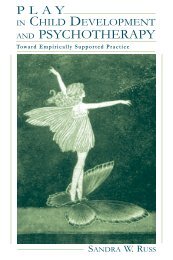Ten Myths About Child Sex Offenders - Fair Play For Children
Ten Myths About Child Sex Offenders - Fair Play For Children
Ten Myths About Child Sex Offenders - Fair Play For Children
- No tags were found...
Create successful ePaper yourself
Turn your PDF publications into a flip-book with our unique Google optimized e-Paper software.
A SituationalPerspective on <strong>Child</strong><strong>Sex</strong>ual AbuseRichard WortleySchool of Criminology and Criminal JusticeGriffith UniversityBrisbaneAustralia
Overview• Traditional Approaches to <strong>Child</strong> <strong>Sex</strong> Abuse• <strong>Ten</strong> <strong>Myths</strong> <strong>About</strong> <strong>Child</strong> <strong>Sex</strong>ual Abuse• A Situational Approach to <strong>Child</strong> <strong>Sex</strong>ual Abuse• Conclusion
Current strategies based on person-centredapproach:• View of offenders as suffering psychopathology• Internally driven• Early onset• Persistent• Specialised• Psychiatric rather than criminal• Identifying and screening risky individuals• Treating known offenders
<strong>Ten</strong> <strong>Myths</strong> <strong>About</strong> <strong>Child</strong> <strong>Sex</strong>ualAbuse• Unhelpful misconceptions about child sexualabuse• Two studies:• Smallbone & Wortley (2000)• Part of QPS ‘Project Axis’• Official data on 323 convicted CSA offenders (not atreatment sample)• 212 detailed, confidential self-report– psychosexualhistories, modus operandi• Test-retest reliability +.9• Smallbone, Wortley & Kebbell – current• Follow-up on 2000 sample plus new participants• Particular focus on onset offence
Myth 1: Most child sex offenders target childrenwho are unknown to them and are located inpublic places• The myth of ‘stranger danger’• 56.5% lived with child• 36.9% knew child• 6.5% stranger• Location• 69% at home• 7% public toilet
Myth 2: Most child sex offenders belong to adeviant subculture that involves high levels ofnetworking among its members• Before arrest• 8% talked to other offenders• 4% member of paedophile group• While in prison• 4% provided with information about accessingchildren• 5% provided with information about clubs
Myth 3: Most child sex offenders arehomosexual• Stated sexual orientation:• 76% female only• 8% male only• 13% both• Choice of victim• 72% female• 28% male• However, homosexual offenders tend to havemore victims
Myth 4: Most child sex offenders begin tooffend sexually at an early age• Mean age of first contact 32.4 years• Modal age 31-40 years (37% of sample)• 10.6% 17-20 years• 6% > 50 years• Most juvenile offenders do not progress to adultsexual offending• However, early onset is associated with higherrecidivism
Myth 5: Most child sex offenders have manyvictims and will invariably reoffend• Number of convictions• 77% first sex offence• Number of victims• 55% one victim• 3%>10 victims• Recidivism• 13% sex offence after 5 years release; 37% for anyoffence (Hanson & Bussiere, , 1998)• reconviction for a sex offence 19.3% after 32 years(Soothillet al 2000)
Myth 6: Most child sex offenders specialise insex crimes• Prior convictions• 57% non sex offences; 23% sex offences• Four time more likely first offence was non-sexual(82% versus 18%)• 5% serial specialists• Reconvictions• Hood et al (2002) – sex offenders four times morelikely to be reconvicted for non-sex offence (8.5 v30.9%) after 6 years• Soothill et al (2000) – child sex offenders four timesmore likely to be reconvicted for non sex offence(19.3 v 76.2%) after 32 years
Myth 7: <strong>Sex</strong>ual attraction to children is rare andconfined to a small group of deviant individuals• High incidence of child victimisation• 34% of women and 16% of men report child sexualvictimisation (Dunne, Purdie & Cook, 2003)• 43% of all sexual assault victims aged 12-17; 17; only 31%over 17 years (Simon(& Zgoba, , 2006)• 17% of males admitted having molested a child(Finkelhor& Lewis, 1990)• Attraction to children by non-paedophiles• Attraction to children as children• <strong>Child</strong> marriage common historically and in manycontemporary cultures• non-paedophile males recorded penile volumeresponses to pre-pubescent pubescent boys and girls (Freund etal, 1972)
Myth 8: Most child sex offenders haveassociated diagnosable sexual disorders• Low incidence of paraphilia• 5.4% exhibitionism• 9% frotteurism• 5% voyeurism• 4.2% public masturbation• 1.2% sexual masochism• Treatment for other problems• 23% for depression• 18% drug and alcohol• 13% anger problems
Myth 9: Most child sex offenders view childpornography: most people who view childpornography sexually abuse children• Use of pornography by offenders• 75% used general pornography• 10% use child pornography• 4% collected pictures• Offending by pornography users• Prior to internet 30% of arrested childpornographers involved in hand-on offending• Current estimates on treatment/convicted samples17-40%• Post internet massive increase in ‘casual’ viewing(one site received 1 million hits in a month)
Myth 10: Reoffending by child sex offenders canbe reliably predicted by mental healthprofessionals.• <strong>Ten</strong>dency of clinicians to over predict• Assume high base rate• <strong>Play</strong>ing safe• Actuarial more accurate but still many errors.<strong>For</strong> the most risky 12% of offenders (identifiedon the Static-99) (Hanson & Bussiere, , 1998)• 39% reconvicted after 5 years• 45% reconvicted after 10 years• 52% reconvicted after 15 years
A Situational Approach <strong>Child</strong><strong>Sex</strong>ual Abuse• Potential to commit child sex offences morewidespread than sexual deviancy model suggests• Evolutionary predisposition for youthful partners,sexual aggression, and self-interest• Failure to learn not to offend• Breakdown of personal, social & situational controls– children victimised because they are vulnerable• <strong>Sex</strong>ual preference for children may be a consequence ofoffending – offending changes offenders• Importance of onset offence – primary prevention
Three types of offenders:• Committed• 23% serial sex offenders• <strong>Sex</strong>ual preference for children• Manipulate environment to create opportunities• Opportunistic• 41% first time sex offenders/versatile criminal history• <strong>Sex</strong>ually ambivalent/generalised poor self-control• Exploit opportunities• Reactive• 36% first time for any offence• No strong attraction to children/conventional• Respond to situational stressors and/or stimulation
Situational prevention:• Crime can be prevented by altering immediateenvironments in which offending occurs toreduce opportunities and other situationalpressures, for example:• Increased guardianship• Environmental design• Work-place protocols• Controlling access to home and facilities• Individual stimulus control and relapse preventionprograms
Conclusions• Current approaches to child sexual abuse based onmisconceptions• Preconceived ideas about likely suspects may hamper criminalinvestigations• Screening will not identify most potential offenders• Treatment/surveillance of known offenders will not preventnew offenders• Not all child sex offenders ‘driven’ to offend (at leastnot initially) – may be deterred by situationalinterventions before they offend• Even committed offenders may be deflected bysituational strategies• Implementation not always easy - need to avoid ‘siegementality’
Further reading:• Smallbone, , S. W., & Wortley, , R. (2000). <strong>Child</strong> sexualabuse in Queensland: Offender characteristics and modusoperandi. . Brisbane: Queensland Crime Commission• Smallbone, , S.W., & Wortley, , R.K. (2001). <strong>Child</strong> sexualabuse: Offender characteristics and modus operandi.Australian Institute of Criminology Trends and Issues in Crimeand Criminal Justice, , No. 193• Smallbone, , S.W., Marshall, W., & Wortley, , R (2008).Preventing child sexual abuse: Evidence, policy and practice.Cullompton, , Devon: Willan• Wortley, , R., & Smallbone, , S. (2006) (eds(eds).Situationalprevention of child sexual offending. Crime Prevention Studies.Monsey, NY: Criminal Justice Press





![The Childcare Act 2006 - Notes [Website] - Fair Play For Children](https://img.yumpu.com/50144819/1/184x260/the-childcare-act-2006-notes-website-fair-play-for-children.jpg?quality=85)




![Bouncy Castles [PDF] - Fair Play For Children](https://img.yumpu.com/45463572/1/184x260/bouncy-castles-pdf-fair-play-for-children.jpg?quality=85)






